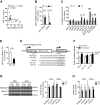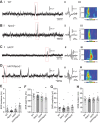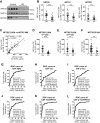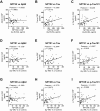NPTX2 and cognitive dysfunction in Alzheimer's Disease
- PMID: 28440221
- PMCID: PMC5404919
- DOI: 10.7554/eLife.23798
NPTX2 and cognitive dysfunction in Alzheimer's Disease
Abstract
Memory loss in Alzheimer's disease (AD) is attributed to pervasive weakening and loss of synapses. Here, we present findings supporting a special role for excitatory synapses connecting pyramidal neurons of the hippocampus and cortex with fast-spiking parvalbumin (PV) interneurons that control network excitability and rhythmicity. Excitatory synapses on PV interneurons are dependent on the AMPA receptor subunit GluA4, which is regulated by presynaptic expression of the synaptogenic immediate early gene NPTX2 by pyramidal neurons. In a mouse model of AD amyloidosis, Nptx2-/- results in reduced GluA4 expression, disrupted rhythmicity, and increased pyramidal neuron excitability. Postmortem human AD cortex shows profound reductions of NPTX2 and coordinate reductions of GluA4. NPTX2 in human CSF is reduced in subjects with AD and shows robust correlations with cognitive performance and hippocampal volume. These findings implicate failure of adaptive control of pyramidal neuron-PV circuits as a pathophysiological mechanism contributing to cognitive failure in AD.
Keywords: Alzheimer's disease; alzheimer’s disease; dementia; immediate early gene; inhibitory neuron; mmediate early gene; neuroscience.
Conflict of interest statement
The authors declare that no competing interests exist.
Figures

















Comment in
-
Identifying faulty brain circuits.Elife. 2017 Apr 25;6:e26942. doi: 10.7554/eLife.26942. Elife. 2017. PMID: 28440224 Free PMC article.
References
-
- Borchelt DR, Ratovitski T, van Lare J, Lee MK, Gonzales V, Jenkins NA, Copeland NG, Price DL, Sisodia SS. Accelerated amyloid deposition in the brains of transgenic mice coexpressing mutant presenilin 1 and amyloid precursor proteins. Neuron. 1997;19:939–945. doi: 10.1016/S0896-6273(00)80974-5. - DOI - PubMed
-
- Borkowski JG, Benton AL, Spreen O. Word fluency and brain damage. Neuropsychologia. 1967;5:135–140. doi: 10.1016/0028-3932(67)90015-2. - DOI
Publication types
MeSH terms
Substances
Grants and funding
LinkOut - more resources
Full Text Sources
Other Literature Sources
Medical
Molecular Biology Databases

